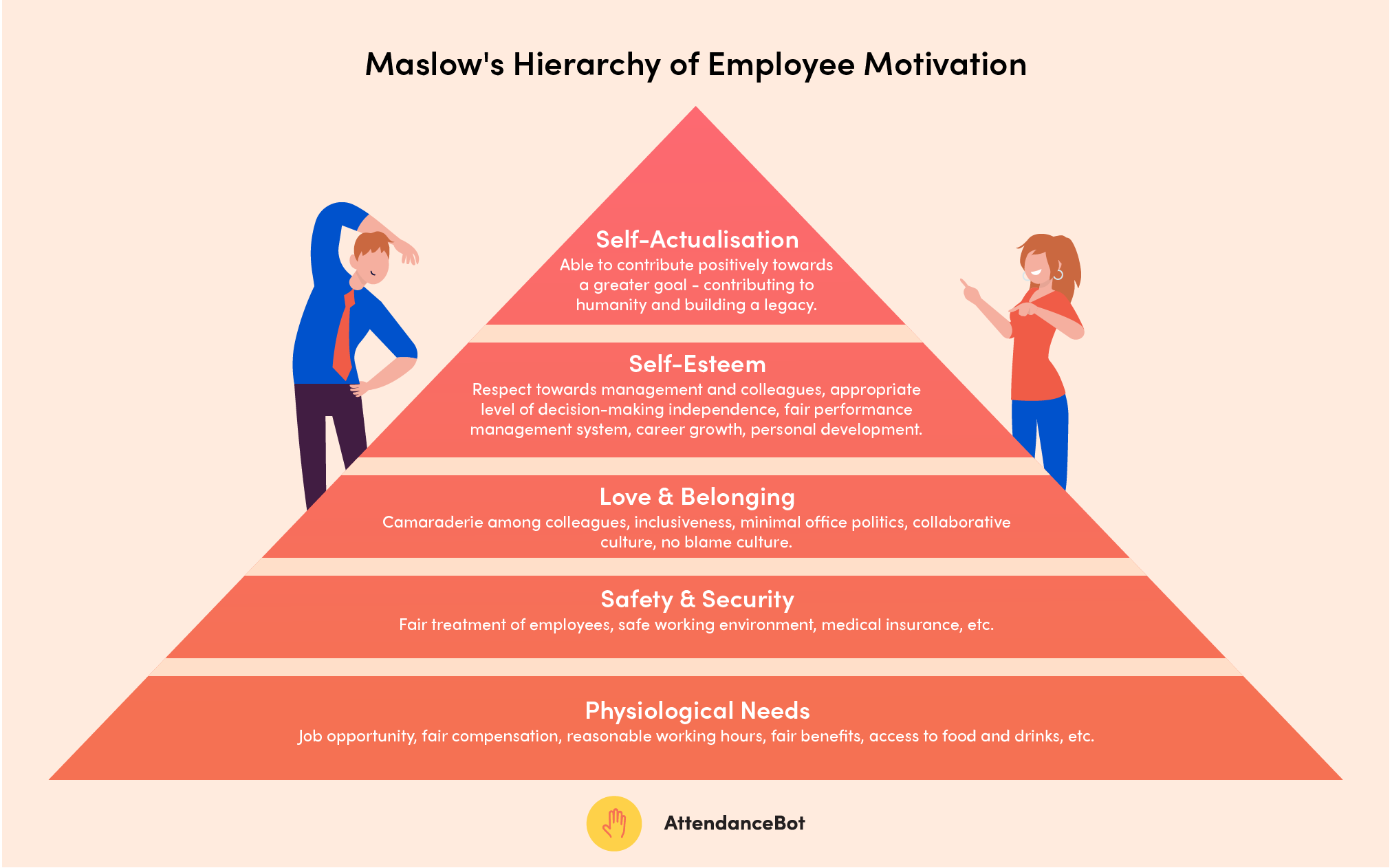What is the basic trait which drives an employee’s urge to work The answer to this question is: Employee Motivation. This is something which should be practised across every organization irrespective of its scale but often takes a backseat.
In this article, we’re talking everything about what work motivation is, how to motivate employees and why it is so important today.
What is employee motivation?
Employee motivation is the enthusiasm and energy with which an employee accomplishes their work. Also what some of you might call work motivation.
Employee motivation is what propels the employee to put in the proverbial 110% into everything they do.
Employee motivation is what drives an employee to push hard and accomplish lofty goals.
Employee motivation is those few words of encouragement for work that makes one want to give it their best.
A highly motivated employee looks forward to Mondays and goes beyond the call of duty to deliver excellence whereas a low motivation employee dreads coming to office, tries to work as little as possible to just stay afloat.
Now let’s understand the different types of work motivation before we jump into how to motivate employees.
What are the types of employee motivation?
Before you start looking for things to improve motivation at work, it is important to understand how to motivate employees. That starts by understanding the two types of triggers that motivate people.

Extrinsic employee motivation
Extrinsic employee motivation is usually the external factors that affect an employee’s performance such as rewards, recognition, and penalization. Extrinsic employee motivation is necessary, because many times, passion is not what drives an employee to do his or her job, it’s the healthy work environment and a hefty compensation.
Let’s take a basic example:
A child is not doing the homework. No amount of motivation can make it enjoyable at the moment. However, if you offer him/her an incentive in the form of money or an object, he/she will gladly finish the homework. This is extrinsic employee motivation.
Intrinsic employee motivation
On the other hand, intrinsic motivation, as the name suggests, depends on the internal factors and personal traits that drive an employee. If the work culture is good and the work itself is enjoyable, then intrinsic employee motivation is high. It is a psychological factor which is intrinsic to the employee, rather than an externally induced one.
Intrinsic motivation, however, may be affected positively by employee rewards, whether in the form of awards, praise, or compensation.
Whether extrinsic or intrinsic, employee motivation is essential. A person will work with utmost dedication and utilize one’s true potential, only when motivation is present. So if you’re wondering how to motivate someone, start by understanding the difference in what drives them.
Why is employee motivation important?
If you want your organization to run full steam ahead, you need to keep the ones who run it happy, in this case, your employees. Employee work motivation is the fuel that keeps them going year after year, not just towards their individual goals but also towards adding value to your organization’s vision, mission, and goals.
So, why is employee motivation important? Let’s find out.

1. Work motivation increases commitment
Employees who are motivated turn out to be more loyal and committed towards the organization. Be it motivation in leadership or the overall team motivation, you will see a difference in the commitment one makes to work almost instantly.
2. Motivating employees increase their satisfaction at work
Intrinsic employee motivation is driven by an employee’s internal feelings towards the organization and the work they’re assigned. Workplace motivation ensures that the employee is happy doing the work that is assigned to them, and feels that it is aligned with their own goals. This gives them an overall feeling of satisfaction. This satisfaction, in turn, increases intrinsic motivation feeding a virtuous cycle.
Therefore it is critical that you take the time to put the right employee on the right project so that the project’s goals are what motivates the person to deliver their best and derive professional satisfaction.
3. Motivation accelerates employee development
Employee motivation contributes towards the overall development of the employee as well. Their professional development automatically contributes to the organization’s progress. So if you haven’t already, make a few motivation strategies a core part of your business growth plan.
4. Motivating a team at work increases employee efficiency
A motivated employee’s work turns out to be better not just in terms of quality but also quantity. Their efficiency grows by leaps and bounds when they feel encouraged and acknowledged. This in turns increases their productivity too. It’s hard to imagine the impact a few words of encouragement for work can have on someone’s efficiency.
5. Encourages better uncertainty management and improves motivation in leadership
Employee motivation ensures that employees are equipped with the skills to handle uncertain situations. This makes them better decision-makers and problem solvers because they are confident. With higher work motivation, you will see many leaders surface.
6. Motivation at work encourages innovation and creation
Employees who are motivated are also prone to bringing forth novel ideas during projects. They are proactive in suggesting bold moves that can take the organization forward. Work inspiration increases by manifolds when you start focusing on how to motivate employees.
7. Motivation increases employee flexibility
Motivated employees also tend to be more flexible. They are happy to stretch their hours and work responsibilities when the need arises. However, this is only possible if they also get designated days and hours off when they need it, thus contributing to their motivation.
8. Workplace motivation lowers absenteeism and attrition rates
As the employees feel motivated and invigorated enough to attend work, there are lesser cases of leaves and resignations. Work motivation runs high enough to make the employees loyal enough to stick with the organization through thick and thin.
9. Motivation in the workplace makes criticism constructive
Motivated employees take criticism in a positive manner. Not only that, but they also use that criticism to perfect their own method and often come up with extraordinary measures. A few words of encouragement for work along with constructive criticism is all you need to make sure of.
10. Motivation at work boosts team spirit
Employee Motivation does not discourage competitive spirit but makes sure that competition does not come in the way of team spirit. Motivated employees inspire their team members and turn out to be better leaders when the time comes.
11. Workplace motivation creates brand ambassador employees
A motivated employee can represent the organization and brand in the best possible manner. They also turn out to be a pro negotiator when it comes to presenting the company in the best light while grabbing a deal. Motivation in business can actually help your organization get more business.
Employee motivation makes sure that the employees perform in the best possible manner so that their attitude towards work benefits the organization in the most optimum way. Employee motivation is the best tool utilizing the human resource to its full potential, keeping both manager and subordinate happy, professionally.
But there’s one more thing you need to learn about before reading on how to motivate employees.
How can you measure employee motivation?
You could be doing a hundred things to improve motivation at work. But how do you know any of the motivation strategies are actually working? How do you know that the little changes you’re implementing are motivating employees?
It is imperative to have a way to measure work motivation. That’s the only way you can plug in the loopholes and work towards bettering motivation in the workplace.
Fortunately, there are a few simple ways of measuring employee motivation:
1. Personal reviews
A great way to measure employee motivation is by having one on one review meetings wherein the performance is assessed and accordingly appraised. The yearly appraisals should not just be monetary in nature. They should also be able to convey to the employees about what worked and what did not, their strengths as well as weaknesses, and whether they are at par with the company’s updated policies and vision.
2. Employee engagement surveys
This is yet another engaging and effective way of measuring employee motivation. You can float around updated surveys and questionnaires which can be filled in by the employees. This specifically helps in the non-appraisal periods.
3. Customer satisfaction surveys
This is an indirect way of understanding your employees; via your customers. The policy is, happier the customer, happier the employees because they have done a phenomenal job. However, if the customer satisfaction rate is low, there is some deficit or gap in the employee motivation as well that needs to be addressed.
Employee motivation should be measured occasionally so that you know that the efforts are not being wasted or are not misdirected. These surveys and interviews should be aimed at understanding what motivates people and then creating motivation strategies that channel their energy in the right direction.
Why do employees lose motivation?
Motivation drives the employees and subsequently the business of an organization. A lack of it, and you will see spiking attrition rates and a word of mouth which can be really bad for the image of the organization. Keeping employees motivated is an essential task for any organization, regardless of its scale.
However, sometimes, despite understanding and implementing the best of employee motivation strategies, workplace motivation just doesn’t seem to increase. The employees feel disheartened and disinterested, either suddenly or gradually.
Why does this happen? What makes employees lose motivation? The reasons are motivation traps.

Work Motivation Trap 1: Lack of care
Employee motivation urges to match an organization’s vision with that of the employee. It is imperative that the two sync. If a certain task or policy doesn’t induce enough care in the employee, there would be a lack of interest, which would reflect in the productivity.
So, how can you take your employee out of this trap? Firstly, do not assume that what may motivate you as a leader can be the motivation factor for your employee as well. Every individual is different. What motivates people can be very different. And what drives your team motivation can be something totally different.
Figure out the values that can be drawn out:
- Identity Value: Chart out how the given task is suited perfectly to the skillset of the employee and will further help him or her grow in their career.
- Interest Value: Make the task compelling, by connecting it to the things which the employee finds interesting.
- Importance Value: Call out to the loyalty factor inside the employee by stating how the said task matters to the organization as the whole.
- Utility Value: Make your employee aware of what he or she would lose out on if the task is not done. Tell them that the cost of not doing the task can be higher than the benefit of actually doing it.
Work Motivation Trap 2: Lack of confidence
This happens when the employees lose motivation as they think they aren’t good enough to do the said task. This lack of confidence leads them to doubt their competence, which further results in a lack of employee motivation.
The best way to help an employee out of this trap would be to boost morale. Also, a good way would be to guide them through the task by breaking it into easy parts instead of one complex mass. Convince them how they are the best pick for the said task, and give them one component at a time, in the order of ease. As the tasks would start clearing, so would the self-doubt in the minds of the employee.
Work Motivation Trap 3: Plenty of negative emotions
Mental health is of utmost importance. With time, everyone’s personal and professional life is becoming extremely successful. This has led to issues such as depression, anxiety, and more, many of which require therapy and medication. Find out if your employee’s revulsion towards a task is due to his or her deteriorating mental condition which is contributing to negative emotions.
The best way to help them out of this is to listen to them actively, without any judgement. Remember that every person’s experience is different. What may be trivial to you may be crucial to your employee. Your job is to make sure that the employee gets out of this dilemma. The employee may often be disoriented if suffering from a mental health condition. Go the extra mile and repeat instructions. Guide when the need be. Convince that you are there in case of any confusion or exasperation and he or she need not panic if there is any bottleneck. This will make sure that the employee feels better, at the same time get the task done in favour of the organization.
If none of this works, the best way would be to recommend counselling and support the employee during the course of it.
Work Motivation Trap 4: Lack of attribution
This is the most challenging trap because here, neither the employee nor you can identify the source of demotivation. Some of the indicators may be frequent sick leaves, frequent evasion of the task, deferring the task by citing lack of time, etc.
The best way to overcome this trap would be to help the employee identify what is the issue behind not doing the said task. Sometimes, they may have a reason embedded in the subconscious mind but may not be able to bring it to the surface. They may also be uncomfortable discussing it professionally. Make sure you make the manager-subordinate relationship so smooth that they can come to you and speak about it. Once you know the reason, you can suggest ways of dealing with it or alternative ways of doing the task in hand.
Employee motivation should come from within but is largely dependent on the factors around. A manager’s attitude towards solving employee’s issues plays a big part here.
How can you increase employee motivation?
In the real world, we might be focussed on identifying low motivation employees and working with them to get them energized, and inspired to work. But the fact of the matter is that what differentiates a highly efficient and/or creative company from another is not the ratio of its highly motivated vs unmotivated employees but the difference between the motivation of an average employee.
So instead of thinking of employee motivation as a person-specific issue, we ought to approach it as a company culture issue and approach it from a structural perspective.
Your employee motivation index is prime and perfect. What next? No component of an organization is static, especially the ever-dynamic human resource component. Employee motivation is dependent on humans, and thus can change depending upon their circumstances, whether professional or personal. Thus, you not only have to make sure that they remain motivated but also a way to elevate the standard of employee motivation. How can you do that? Let’s find out.
Remember the thumb rule of employee motivation or team motivation: an employee who is more in control of her affairs is more confident. You have to make sure that as a part of your employee motivation plans, that confidence never wavers. That can be done in the following ways:
1. Choose the right leaders and coaches
Have a keen eye for who can be a leader. A person can be highly skilled, but that does not automatically make him or her a leader. Identify specific skills and choose a leader or coach of a team accordingly.
2. Teach and guide your leaders
You have chosen the leader, but your work doesn’t end there. Use your experience and expertise to constantly guide and teach them so that they can manage the teams well and also not get stuck in sticky situations.
3. Improve communication
This is the basic tenet for any employee policy. Good employee motivation is one which does not have any communication gap. This ensures smooth streamlining of affairs.
4. Define precise and realistic engagement goals
Employee motivation should be connected with SMART goals, i.e. goals that are achievable and realistic. Objectives which have no end in sight and are over-ambitious can only lead to demotivation and subsequent deterioration of morale in the employees. Read our blog on setting SMART goals.
5. Welcome their ideas
Every idea is unique, treat it as such. Listen to your employees and appreciate what they have to say. Make sure you use words of encouragement for work. Even if you do not agree with a certain idea make sure you acknowledge a part of it and then go on to transform it into one that is actually useful for the organization. This ensures that no employee loses his or her voice within the company.
6. Give structured feedback
Employee motivation is better when matched with accurate feedback. Make sure that you give your employees feedback on how their ideas and performances fare, and how they can improve it.
7. Empower your employees
Give your employees the freedom to make decisions. An employee who feels empowered is the one who will eventually not only be motivated but would motivate others as well. Read how you can do this on the Balance Careers blog.
8. Positivity
Create a safe and positive environment with minimal politics and toxicity around. Make sure that there is always an ear to listen to the grievances, if any, and to give solutions therein. Do not micromanage.
9. Employee appreciation
A kind word goes a long way. It is extremely important to keep appreciating your employees so that their self-worth is high. We wrote an extensive post on how you can motivate people with employee appreciation. Read it here.
10. Understand what motivates people
Employee motivation is not a general concept which can be uniformly applied across all levels and at any time. You are dealing with humans here; each unique with their own perspective. Try and understand what inspires and motivates them and use that knowledge to create a better work environment for them.
Employee Motivation: Where should you draw the line?
Employee motivation is an extremely attractive and idealistic concept. One has to understand that humans can be grateful when loaded with appreciation and motivation, but the same, if overdone, can turn into dangerous overconfidence as well.
Thus, where does one draw the line? By knowing the disadvantages of employee motivation:
- Employee entitlement – Some of the employees, if they are continuously performing well, can become complacent. While this can encourage them to be more ambitious and powerful for their own professional development, this is a toxic attitude within the team.
- Employee ignorance – Due to some star employees taking up constant space, others may feel left out and may lose out interest in trying anything new, eventually. You do not want that situation.
- Rebellion – Management may face a strike or lockdown situation if the left out employee dissatisfaction increases and they unite on the sentiment of management’s ignorance towards them.
- Grapevine – Continuous appreciation of certain employees and demotivation inside the others can lead to gossip and grapevine which can ruin the culture of the organization.
Improving your employee motivation: How to get started?
The most efficient way of explaining this would be Maslow’s Hierarchy of Needs. According to this theory, there are five basic tenets that drive employee motivation: physiological, social, safety, self-actualization, and esteem. These are the principles that influence a person’s behaviour and can thus induce motivation or demotivation.
Maslow’s Hierarchy of Needs is considered a holy grail when it comes to understanding employee motivation. Take a look at the chart to know more.

Employee motivation is an overlooked source of competitive advantage. Just by making small tweaks and being focussed on employee motivation as a strategic goal for the top management, you would be able to do a lot more with the same team so that the total would be greater than the sum of parts. Are you doing the same?



